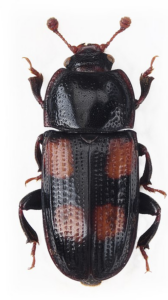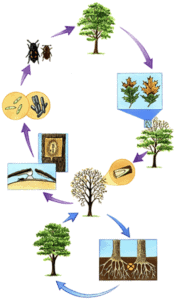Ceratcystis fagacearum is the most destructive disease destroying Texas trees. It is more commonly known as oak wilt. This disease is far reaching from Wisconsin to Texas. The devastation has been vast and will likely continue to get worst. Oak wilt is an infectious disease caused by a fungus known as Bretziell fagacarum.
All species of oak trees can be infected with the fungus. Trees in the red oak group, which include shuman oak, blackjack oak, water oaks, and Texas red oaks are most susceptible to oak wilt and play a major role in the creation of new infections. Other oak groups including white oak and live oak show some tolerance to oak wilt, but are not immune from infection.
Oak wilt is a vascular disease, as the fungus spreads throughout the tree it will eventually block the transmission of nutrients to the canopy causing wilt and discoloration. Damage often occurs underneath the bark which will crack and peel away from the trunk. Often there will also be a rotten smell. If these conditions are present testing for oak wilt and other diseases is available by the Texas Plant Disease Diagnostic Laboratory http://plantclinic.tamu.edu
HOW DOES OAK WILT SPREAD
Oak wilt spreads most commonly by insects and interconnecting roots.
- INSECTS: the biggest culprit is the Nitidulid Beetle. It feeds on the sap of infected trees and then carries the fungal spores to new trees. Fungal mats form beneath the bark of diseased red oaks and produce spores for a few weeks. The beetle and other insects are attracted to a fruity odor spread by the fungi mats. The fungus is transmitted by these insects as they surface and go to fresh wounds, created by nature and man, on healthy trees. The Nitidulid Beetles are most active from February through June, avoid pruning during this period.

- INTERCONNECTING ROOTS: when trees are close to each other the fungus can be transmitted from tree to tree via under the surface root grafting. Roots will grow together and share pathogens.

WHAT CAN PROPERTY OWNERS DO:
Oak wilt has reached a wide-spread problem in parts of Texas. At this time there is no cure. There are guidelines, issued by The Texas A&M Forest Service and the U. S. Department of Agriculture to help prevent further spread and tree destruction.
- Avoid pruning or wounding oaks between February 1 and July 1. The least hazardous periods for pruning are during the coldest days of midwinter or extended periods of hot weather in mid- to late summer.
- Sterilize/Sanitize all pruning equipment between, after use, using denatured methyl alcohol (shellac thinner), isopropyl alcohol, or a general-purpose household disinfectant. Using household bleach is NOT recommended as it can be corrosive to pruning tools as well as people.
- Immediately paint all wounds on oaks to prevent contact with contaminated beetles. Wounds can be either man made or natural and include freshly-cut stumps and damaged surface roots.
- Do not transport or buy unseasoned firewood. Seasoned firewood (dried for at least one year) should not present a threat of spreading oak wilt. Also, burning infected wood cannot transmit oak wilt.
- Promptly remove and either burn or bury all red oaks that are dying or have been recently killed by oak wilt. Generally, this would be oak wilt-infected red oaks that die in the late summer or fall. This will prevent nitidulid beetles from spreading spores from fungal mats that may form on the trees in the fall or the following spring.
- In dense groupings tree’s roots are often connected and the fungus is transported from tree to tree. The most common technique to reduce or stop this transfer is to sever roots by digging 4-feet deep with trenching equipment. To protect groups of uninfected trees trenches should be 100-feet from infected trees. If there are healthy trees within the 100-foot barrier you should consider uprooting and removal, this will improve the barrier to transmission through roots. Untreated trees, outside of the established barrier should be closely inspected for several years to make sure the oak wilt has not crossed the barrier.
Below are additional resources about this subject:
https://tfsweb.tamu.edu/OakWiltFAQS/
https://efotg.sc.egov.usda.gov/references/public/TX/FactSheet-OakWilt.pdf

Ranch Connection is a full service Land and Ranch Real Estate Brokerage established in 1984.
If we can assist you with selling your ranch/land please contact us at cynthia@ranchconnection.com
Please visit our website at www.ranchconnection.com
By: Dave Norris – davenorris@ranchconnection.com
